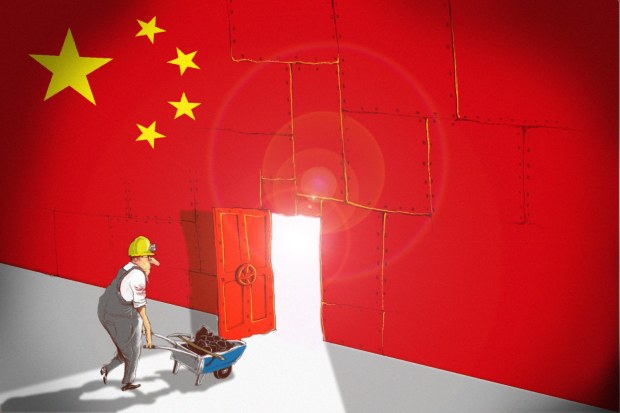Iron ore tumble puts BHP in bear territory
China stimulus efforts haven’t delivered a promised surge in economic activity, putting pressure on steel mills, iron ore prices and big miners’ shares.
Jun 21, 2022 – 10.35am
Hindsight is a wonderful thing, but arguably the big surprise about the iron ore price is not that it’s now tumbling, but that it held up so well for so long.
As Chanticleer wrote last month when the current price slide started, China has spent most of this year caught in a bind between stamping out COVID and stimulating the economy.
China’s struggles to stimulate its property sector are weighing on iron ore prices. David Rowe
The price of iron ore rose from about $US110 a tonne at the start of 2021 to $US156 a tonne in March even as China’s Draconian lockdowns raged, as traders and steel mills responded to loud and repeated promises from the government to stimulate the economy and hit China’s 5.5 per cent GDP growth target for calendar 2022.
But promises can only take you so far. The 8 per cent plunge in the iron ore price on Monday night to $US112.35 a tonne suggests those same traders and steel mills are losing confidence in a second-half surge in Chinese growth.
The profit margins of steel mills have long been key to the direction of the iron ore price and right now they are under severe pressure, as tepid demand leaves the mills sitting on stockpiles of steel built up in anticipation China’s stimulus would work. One index of Chinese steel profits has plunged by almost 90 per cent so far this month.
Indeed, margins are so bad that there are multiple reports that steel mills are now idling their blast furnaces and bringing forward planned maintenance to limit their losses, heaping downwards pressure on the iron ore price.
“The more you produce, the more you lose,” an international trader told Platts of the steel mills’ plight.
The tumble in the price - and further pressure on futures prices, which are down almost 3 per cent - was likely compounded by China’s decision not to reduce official interest rates, despite the ugly economic slowdown it is facing.
But as Craig Botham, chief China economist at Pantheon Macroeconomic notes, China’s decision to keep policy rates on hold was logical given there is little evidence anyone wants to borrow.
“The problem…is that monetary policy at this point is pushing on a string. Rate cuts and liquidity injections only work if there is demand for credit which is going unmet because it is currently too expensive or too scarce,” Botham says.
China is certainly not holding back on stimulus efforts, particularly in the areas that iron ore prices are most sensitive to.
Infrastructure investment project approvals have tripled in a bid to get this sector moving again. And in the property sector, which is estimated to account for about 40 per cent of iron ore demand, officials are madly trying to reverse the crackdown on indebted developers launched last year and get sales moving again.
Some 140 cities are said to have issued policies supporting property sales this year, including everything from easing home purchase restrictions and reducing down payment ratios, to allowing interest only repayment periods, to straight out home purchase subsidies.
But the results have so far been unimpressive. While house sales recorded their first month-on-month gains for the year in May, volumes were still 42 per cent lower than the prior year. New house prices recorded their ninth consecutive monthly fall in May, while sales of existing homes recorded their largest monthly drop since February 2015.
Patchy economic activity due to lockdowns and a lack of confidence in the pivotal property sector is not a recipe for demand or confidence.
Pantheon’s Botham says as in previous property downturns, household deposits are rising, suggesting precautionary saving. Corporates aren’t too keen to borrow, either, given slows growth. ”Absent stronger domestic demand, they have little reason to borrow to invest, and most borrowing demand will be to meet short-term financing needs.“And embattled property developers would love to get their hands on funds, but they aren’t allowed to because the Three Red Lines rules, which impose restrictions on developer debt levels, are still in place.
How China escapes this slowdown remains to be seen. Ending the COVID lockdowns will of course be important, but Botham argues fiscal policy needs to take over the heavy lifting. “A successful fiscal stimulus would also boost aggregate demand and increase private sector credit demand, making monetary easing less futile than it currently would be.”
But increasing demand for steel may take some time. And until then, steel mill margins and iron ore prices are likely to remain under pressure.
Of course, investors in BHP, Rio Tinto and Fortescue Metals Group need to keep this in context - even at the current iron ore prices, the trio’s low cost bases mean they are making huge profits and still have the capacity to pay big dividends. BHP’s cost guidance, for example, is between $US17.50 and $US18.50 a tonne; in the context of a long run iron ore price of around $US60 a tonne, these are very strong margins.
Still, the miners have tumbled since late April, with BHP now down almost 25 per cent, Rio down 15 per cent and FMG down about 20 per cent.
Until we know more about whether China’s stimulus promises are actually working, the market may be cautious on Australia’s resources giants.
- Forums
- ASX - General
- Its Over
Its Over, page-13124
-
- There are more pages in this discussion • 11,205 more messages in this thread...
You’re viewing a single post only. To view the entire thread just sign in or Join Now (FREE)
Featured News
Featured News
The Watchlist
I88
INFINI RESOURCES LIMITED
Charles Armstrong, MD & CEO
Charles Armstrong
MD & CEO
Previous Video
Next Video
SPONSORED BY The Market Online





